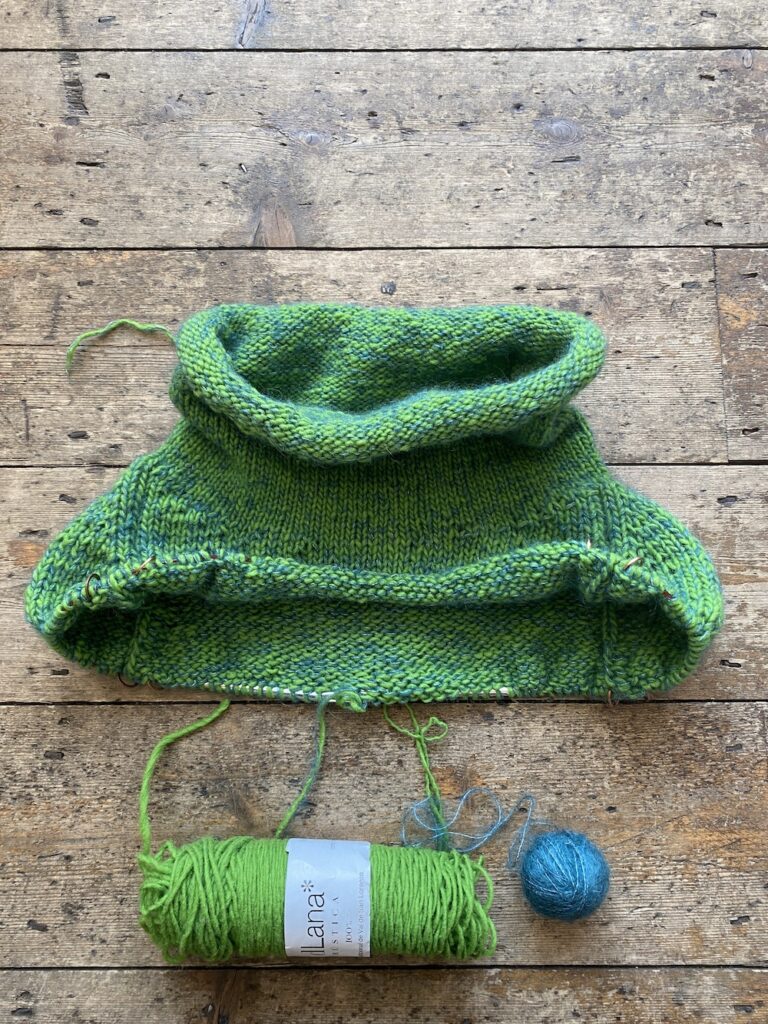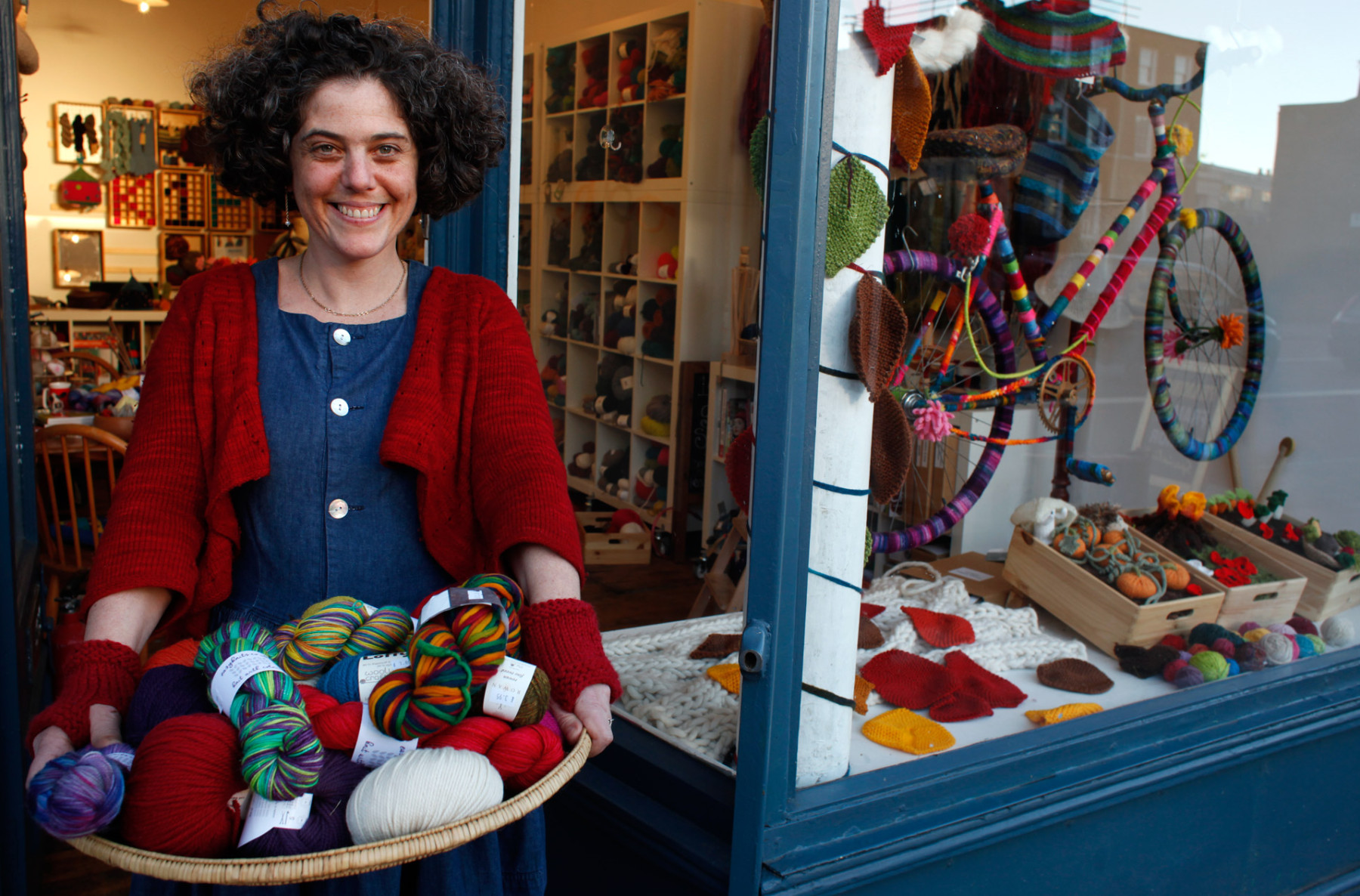One strand good, 2 strands better? Really? Will the addition of that super-skinny thread really make a difference? And if i’m not that great of a knitter will I be able to manage it? And oh my, it’s looking p r e t t y pricey now you’ve added in those extra balls of fluff, so what about we leave them out – will the jumper still work?
Ok, ok already. I hear you. We’re going to talk about adding (and leaving out) the extra strand of mohair silk to your main woolly yarn, how it works and what difference it makes. As this newsletter is being written atop a very comfy fence you will notice that throughout this discussion I remain impartial, Switzerland-like in my advice on the topic. The mohair-nohair debate is a personal choice and my purpose here is to inform you so you can make the decsion yourself.
Let’s begin with what it is. We’re talking about knitting with an extra lace-weight strand of yarn that is a blend of kid (baby goat) mohair and silk. It is silky on account of the silk and soft on account of the super-fineness of the kid mohair. The mohair also brings its fluffiness along for the ride. So if you hold a strand of the yarn in front a window, you’ll see its characteristic halo diffusing the light around it. Because the yarn is spun to a very thin gauge, it is almost inconsequential in thickness terms. But all that fluff has a way of catching air, meaning that if you give your stitches enough space, the yarn will take in it’s own floofy airy bulk. So to summarise, when you knit a regular woolly yarn together with a strand of mohiar silk, you are adding silkiness, softness, a fluffy halo, and if you knit at a loose-ish gauge, you’ll also add in some bulk (which is actually weightless as it is air).
The other thing which it may be adding is of course, colour. A same colour mohair silk that matches the main yarn, will tone in and disappear. Likewise you can also darken or lighten your main yarn with the mohair, or you can pick a total colour contrast. This will tend to do the mixing thing you expect from combining two different shades, albeit in that slightly marled way that you get when mixing threads – but with 2 important qualifications: the mohair silk strand is much thinner and so brings a lot less of its colour into the fabric whilst at the same time providing all the colour to the fluffy halo that hovers around the fabric. So a pink wool with an orange mohair silk will give you a mainly pink sweater that glows orange. My grass green wool with its teal mohair silk is knitting into a mainly sea green fabric, encased in a turquoise haze.

Ok, so you get how it changes the feel and look of the fabric – what about what it’s doing to your stitch gauge and what that means for substituting in a different yarn? On the one hand, you’re adding the thickness of a lace-weight to the thickness of your other bulkier yarn. Relationship-wise, the mohair is a sauce or condiment to the main yarn. It’s not the bit that will fill you (or your sweater) up. It’s going to add some flavour and a bit of weight. How much? Well just a little bit. It will take a DK up to a worsted, a sport up to a DK, a 4ply up to a sport – can you see where I’m going with this? But it also changes the look of the gauge that your pattern calls for. Add mohair silk to a fabric that’s designed to have a loose and floppy gauge, and you’re not adding density to it, but rather replacing the daylight between the stitches with a light-diffusing fluffy cloud. A tighter gauge fabric on the other hand may hide the mohair silk to the point of being nearly invisible as the fluff will have no room to express itself. Its transformative powers lie hidden in the handle of the fabric which will go from rustic and woolly to glamourous and cashmere-ish with just one strand.
So what if that slinky silky floofy fluffy thing is not your thing? You really like the shape of the sweaters designed by those beige Scandi designers, you’d like to make them but you’re just not a furry kind of knitter. No need to explain – really – I get it (really I do!). Happily for all of us, Ravelry tells us about the thickness of each of the yarns used in the pattern and then also gives us a single thickness of the two combined. So all you need to do is look for a yarn which corresponds to that combined thickness, and check that you like the feel of it at the recommended gauge.
And finally, is it really as easy knitting with two strands as one?
Well, yes and no.
Holding two strands together and treating them as one whilst you knit, doesn’t need any special training or tutorials. You just take the ends of the yarn from each ball, hold them together and knit. But based on what we know about a ball of wool’s propensity to get itself into a tangle, obviously 2 balls of wool can get into twice as much of a tangle – meaning you will need to stop and do some ball maintenance periodically. A small price to pay for turning shetland into cashmere, or a totally unnecessary and quite expensive faff?
This is a question for you, and your answer will be the right answer on account of it being from you and about your knitting. It also happens to be one of the more marvellous things about knitting things ourselves – we get to make them our way and for that to be the way they’re supposed to be. And that’s exactly the point where I jump off my Swiss fence, come back to Clapton and announce that that is the knitting I am most in favour of :o)

